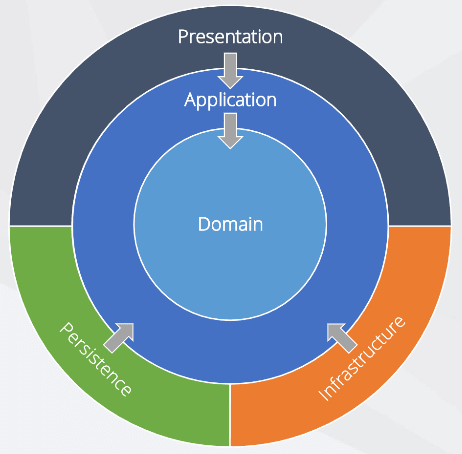Introduction 介绍
In the ever-evolving world of software development, finding the right architectural pattern is akin to selecting the foundation for a building. One such architectural paradigm that has gained recognition for its ability to promote maintainability, flexibility, and testability is the Onion Architecture. This article takes you on a journey through the layers of Onion Architecture, unveiling its principles, benefits, and real-world applications. Whether you're a seasoned developer looking to deepen your architectural knowledge or a curious novice eager to explore innovative software design, this article will serve as your guide to understanding and implementing Onion Architecture in your projects.
在不断发展的软件开发世界中,找到正确的建筑模式类似于选择建筑物的地基。洋葱架构就是这样一种架构范式,因其提高可维护性、灵活性和可测试性的能力而获得认可。本文将带您了解洋葱架构的各个层面,揭示其原理、优点和实际应用。无论您是希望加深架构知识的经验丰富的开发人员,还是渴望探索创新软件设计的好奇新手,本文都将作为您在项目中理解和实施洋葱架构的指南。
What Is Onion Architecture?
什么是洋葱架构?
Onion Architecture is a software architectural pattern that emphasizes the separation of concerns and the organization of an application into distinct, concentric layers or "onions."
洋葱架构 是一种软件架构模式,强调关注点的分离以及将应用程序组织成不同的同心层或“洋葱”。
At the core of Onion Architecture is the concept of dependency inversion .
洋葱架构的核心是 依赖倒置 的概念。
This principle, which is one of the SOLID principles, encourages the inversion of the traditional dependencies between higher-level and lower-level modules. In the context of Onion Architecture, this means that inner layers depend on outer layers, while outer layers remain independent of the inner layers.
这一原则是 SOLID 原则之一,它鼓励在更高级别和较低级别模块之间颠倒传统依赖关系。在洋葱架构的背景下,这意味着内层依赖于外层,而外层则独立于内层。
Run Code from Your Browser - No Installation Required
从浏览器运行代码 - 无需安装
Get started 开始使用

Key Layers of Onion Architecture
洋葱架构的关键层
The Onion Architecture typically consists of several concentric layers, each with a specific responsibility:
洋葱架构通常由几个同心层组成,每个层都有特定的职责:
-
Core Layer : This innermost layer, also known as the "Domain Layer" or "Model Layer," contains the core business logic, entities, and domain-specific rules. It is agnostic to any external frameworks or technologies;核心层 :这个最里层,也称为“域层”或“模型层”,包含核心业务逻辑、实体和特定于域的规则。它与任何外部框架或技术无关;
-
Application Layer : The layer surrounding the Core is the "Application Layer." It acts as an intermediary between the Core and the outer layers, handling application-specific use cases, orchestrating business logic, and often containing application services;应用层 :核心周围的层是“应用层”。它充当核心层和外层之间的中介,处理特定于应用程序的用例,编排业务逻辑,并且通常包含应用程序服务;
-
Infrastructure Layer : The Infrastructure Layer is responsible for interacting with external systems, services, and frameworks. It includes database access, third-party integrations, and any technology-specific implementations. This layer typically depends on the Core and Application layers but is not dependent on them;基础设施层 :基础设施层负责与外部系统、服务和框架进行交互。它包括数据库访问、第三方集成和任何特定于技术的实现。该层通常依赖于核心层和应用程序层,但不依赖于它们;
-
Presentation Layer : The outermost layer is the "Presentation Layer," which deals with user interfaces and user interaction. This layer can be web-based, desktop-based, or any other form of user interface. It communicates with the Application Layer to request and display data, but it is independent of the inner layers.表示层 :最外层是“表示层”,它处理用户界面和用户交互。此层可以是基于 Web、基于桌面或任何其他形式的用户界面。它与应用层通信以请求和显示数据,但它独立于内部层。

Onion Architecture Implementation Example in Python
Python 中的洋葱架构实现示例
Let's consider the following Python code:
让我们考虑以下 Python 代码:
# Application layer (entry point)
def main():
app = Application()
app.run()
# Domain layer (business logic)
class Application:
def __init__(self):
self.service = Service()
def run(self):
result = self.service.process_data()
print(result)
# Infrastructure layer (data processing, external dependencies)
class Service:
def __init__(self):
self.repository = Repository()
def process_data(self):
data = self.repository.get_data()
return data
# Data access layer (abstraction over data storage)
class Repository:
def get_data(self):
# Implementation for accessing data from a database, file, API, etc.
return "Data from external source"
-
Application layer: This layer is the entry point to the application. It creates an instance of the Application class and calls its run method;应用层: 此层是应用程序的入口点。它创建 Application 类的实例并调用其 run 方法;
-
Domain layer: This layer contains the core business logic of the application. The Application class encapsulates the use of the Service class, which represents a higher-level domain service;域层: 该层包含应用程序的核心业务逻辑。 Application 类封装了 Service 类的使用,该类表示更高级别的域服务;
-
Infrastructure layer: This layer handles data access and external dependencies. The Service class uses the Repository class to access data;基础设施层: 该层处理数据访问和外部依赖关系。 Service 类使用 Repository 类访问数据;
-
Data access layer: This layer abstracts the details of data storage. The Repository class provides a generic interface for retrieving data, without specifying the underlying implementation (e.g., database, file).数据接入层: 该层抽象了数据存储的细节。 Repository 类提供了一个用于检索数据的通用接口,而无需指定底层实现(例如,数据库、文件)。
Key points of onion architecture
洋葱架构的要点
-
Dependency direction: Inner layers depend only on outer layers, promoting loose coupling;依赖方向: 内层仅依赖于外层,促进松耦合;
-
Abstraction: The Repository class acts as an abstraction layer, hiding the details of data storage;抽象化: Repository 类充当抽象层,隐藏数据存储的细节;
-
Layers: The application is divided into distinct layers, each with a specific responsibility;层: 应用程序分为不同的层,每个层都有特定的职责;
-
Testability: The onion architecture makes it easier to write unit tests, as inner layers can be tested independently.测试: 洋葱架构使编写单元测试变得更加容易,因为内层可以独立测试。
What is Dependency Inversion?
什么是依赖倒置?
Dependency Inversion is a crucial concept in software design and architecture that promotes the decoupling of high-level modules from low-level modules, reducing the dependency of one on the other. It is one of the SOLID principles, initially introduced by Robert C. Martin, which stands for the "D" in SOLID.
依赖倒置 是软件设计和架构中的一个关键概念,它促进了高级模块与低级模块的解耦,减少了一个模块对另一个模块的依赖。它是 SOLID 原则之一,最初由 Robert C. Martin 提出,代表 SOLID 中的“D”。
Understanding dependency inversion principle
了解依赖倒置原理
At its core, the Dependency Inversion Principle (DIP) suggests two essential guidelines:
从本质上讲,依赖倒置原则 (DIP) 提出了两个基本准则:
-
High-level modules (or abstractions) should not depend on low-level modules (concrete implementations). Both should depend on abstractions;高级模块 (或抽象)不应依赖于低级模块(具体实现)。两者都应该依赖于抽象;
-
Abstractions should not depend on details. Details should depend on abstractions.抽象 不应依赖于细节。细节应取决于抽象。
In other words, rather than coding to specific implementations, developers should code to interfaces or abstract classes. This inversion of control allows for more flexible, extensible, and maintainable software systems.
换句话说,开发人员应该对接口或抽象类进行编码,而不是对特定实现进行编码。这种控制反转允许更灵活、可扩展和可维护的软件系统。
Dependency inversion with Python
使用 Python 进行依赖关系反转
Dependency Inversion is closely related to the use of interfaces, abstract classes, and dependency injection techniques .
依赖倒置与 接口、抽象类和依赖注入技术 的使用密切相关。
In the context of onion architecture , this principle is applied to ensure that:
在洋葱架构的上下文中 ,应用此原则来确保:
-
Inner layers (core domain logic) remain independent of external dependencies (infrastructure);内部层(核心域逻辑) 保持独立于外部依赖项(基础设施);
-
Outer layers (infrastructure) are built around abstractions defined by inner layers.外层(基础设施) 是围绕内层定义的抽象构建的。
For example, we can consider the following code in Python:
例如,我们可以考虑 Python 中的以下代码:
# Application layer
class Application:
def __init__(self, data_service):
self.data_service = data_service
def run(self):
data = self.data_service.fetch_data()
# Process data
print(data)
# Domain layer
class DataService:
def __init__(self, data_repository):
self.data_repository = data_repository
def fetch_data(self):
data = self.data_repository.get_data()
# Process data
return data
# Infrastructure layer
class DataRepository:
def get_data(self):
# Retrieve data from a database
return "Data from database"
-
Dependency Inversion :依赖关系倒置 :
-
The Application class depends on the DataService interface, not a specific implementation;Application 类依赖于 DataService 接口,而不是特定的实现;
-
The DataService class depends on the DataRepository interface, not a specific implementation.DataService 类依赖于 DataRepository 接口,而不是特定的实现。
-
-
Onion Architecture :洋葱架构 :
-
The Application layer (inner layer) depends on the DataService (domain layer);应用层(内层)依赖于 DataService (域层);
-
The DataService depends on the DataRepository (infrastructure layer). This ensures that the core domain logic (application and data service) is independent of the specific data source (file or database).DataService 依赖于 DataRepository (基础设施层)。这可确保核心域逻辑(应用程序和数据服务)独立于特定数据源(文件或数据库)。
-
-
Flexibility : 灵活性 :
-
To change the data source, you only need to replace the DataRepository implementation. The DataService and Application classes remain unchanged.要更改数据源,您只需替换 DataRepository 实现。 DataService 和 Application 类保持不变。
-
Start Learning Coding today and boost your Career Potential
立即开始学习编码并提升您的职业潜力
Start today! 从今天开始!

Pros and Cons of Onion Architecture
洋葱架构的优缺点
| Feature 特征 | Pros 优点 | Cons 缺点 |
| Modularity 模块性 |
Easier to understand, maintain, and extend codebase
更易于理解、维护和扩展代码库
|
Increased complexity for smaller applications
小型应用的复杂性增加
|
| Testability 测试 |
Facilitates unit testing and reduces debugging time
促进单元测试并减少调试时间
|
Initial learning curve for developers
开发人员的初始学习曲线
|
| Flexibility 灵活性 |
Allows for easy changes to business requirements
允许轻松更改业务需求
|
Potential for performance overhead
潜在的性能开销
|
| Isolation of Concerns 关注点的隔离 |
Separates business logic from external concerns
将业务逻辑与外部关注点分开
|
May require more boilerplate code
可能需要更多样板代码
|
| Maintainability 可维护性 |
Improves code maintainability and reduces the impact of changes
提高代码可维护性并减少更改的影响
|
Dependency management can be challenging
依赖项管理可能具有挑战性
|
| Scalability 可扩展性 |
Enables easy scaling of specific layers or components
能够轻松扩展特定层或组件
|
Not suitable for every project
并非适合每个项目
|
| Dependency Inversion 依赖关系反转 |
Promotes loose coupling and flexibility
促进松散耦合和灵活性
|
Increased development time for setup
增加设置的开发时间
|
| Reusability 可 重用 |
Encourages code reuse and modularity
鼓励代码重用和模块化
|
Can introduce unnecessary complexity for smaller applications
对于较小的应用程序,可能会带来不必要的复杂性
|
It's important to weigh the pros and cons of Onion Architecture carefully based on your project's specific requirements and constraints. While it offers several advantages in terms of maintainability and flexibility, it may not be the best choice for every software development endeavor.
根据项目的具体要求和限制仔细权衡洋葱架构的优缺点非常重要。虽然它在可维护性和灵活性方面提供了多种优势,但它可能不是每个软件开发工作的最佳选择。
FAQs 常见问题
Q: What is Onion Architecture?
问: 什么是洋葱架构?
A: Onion Architecture is a software architectural pattern that emphasizes the separation of concerns by organizing a software application into concentric layers, with each layer serving a specific purpose and level of abstraction.
一个: 洋葱架构是一种软件架构模式,它强调通过将软件应用程序组织成同心层来分离关注点,每一层都有特定的目的和抽象级别。
Q: What are the main components or layers in Onion Architecture?
问: 洋葱架构中的主要组件或层是什么?
A: Onion Architecture typically consists of four main layers: Core, Application, Infrastructure, and Presentation. The Core layer contains the application's business logic, the Application layer handles use cases and application services, the Infrastructure layer deals with data access and external dependencies, and the Presentation layer is responsible for user interfaces.
一个: 洋葱架构通常由四个主要层组成:核心层、应用程序层、基础设施层和演示层。核心层包含应用程序的业务逻辑,应用层处理用例和应用程序服务,基础设施层处理数据访问和外部依赖关系,表示层负责用户界面。
Q: What is the advantage of using Onion Architecture?
问: 使用洋葱架构有什么优势?
A: One of the main advantages of Onion Architecture is its modularity and testability. It promotes clean separation of concerns, making it easier to develop and maintain software. It also allows for extensive unit testing.
一个: 洋葱架构的主要优势之一是其模块化和可测试性。它促进关注点的干净分离,使软件的开发和维护变得更加容易。它还允许进行广泛的单元测试。
Q: How does Onion Architecture relate to the Dependency Inversion Principle (DIP)?
问: 洋葱架构与依赖反转原则 (DIP) 有何关系?
A: Onion Architecture adheres closely to the Dependency Inversion Principle (DIP), which states that high-level modules should not depend on low-level modules but rather both should depend on abstractions. This principle helps achieve flexibility and loose coupling in the architecture.
一个: 洋葱架构严格遵守依赖反转原则 (DIP),该原则指出高级模块不应依赖于低级模块,而两者都应依赖于抽象。这一原理有助于在架构中实现灵活性和松耦合。
Q: Is Onion Architecture suitable for all types of software projects?
问: 洋葱架构是否适用于所有类型的软件项目?
A: While Onion Architecture offers benefits like maintainability and testability, it may not be necessary for small or straightforward projects. It is best suited for complex applications with evolving requirements.
一个: 虽然 Onion Architecture 提供了可维护性和可测试性等优势,但对于小型或简单的项目来说可能没有必要。它最适合要求不断变化的复杂应用。
Q: Can existing projects be refactored to use Onion Architecture?
问: 现有项目可以重构以使用 Onion Architecture 吗?
A: Yes, it is possible to refactor existing projects to follow Onion Architecture principles. However, it may require careful planning and migration strategies to avoid disrupting the existing functionality.
一个: 是的,可以重构现有项目以遵循 Onion 架构原则。但是,可能需要仔细规划和迁移策略,以避免中断现有功能。
Q: Are there any specific tools or frameworks for implementing Onion Architecture?
问: 是否有任何特定的工具或框架来实现洋葱架构?
A: Onion Architecture is more of a design principle than a specific framework. Developers can implement it in various programming languages and platforms. However, some development frameworks, such as ASP.NET Core, offer features that align well with Onion Architecture.
一个: 洋葱架构更像是一种设计原则,而不是一个特定的框架。开发人员可以用各种编程语言和平台实现它。然而,一些开发框架(例如 ASP.NET Core)提供了与 Onion Architecture 非常一致的功能。
Q: What are some real-world examples of applications using Onion Architecture?
问: 使用 Onion Architecture 的应用程序有哪些实际示例?
A: Several software applications and systems, including content management systems, e-commerce platforms, and enterprise-level applications, have successfully adopted Onion Architecture to improve maintainability and scalability.
一个: 一些软件应用程序和系统,包括内容管理系统、电子商务平台和企业级应用程序,已经成功采用了洋葱架构来提高可维护性和可扩展性。
Q: Does Onion Architecture impose performance overhead due to its layers?
问: 洋葱架构是否会因其层而产生性能开销?
A: While Onion Architecture introduces some level of abstraction, the performance overhead is generally minimal in most applications. The benefits of clean separation of concerns often outweigh any minor performance considerations.
一个: 虽然洋葱架构引入了一定程度的抽象,但在大多数应用程序中,性能开销通常很小。干净地分离关注点的好处通常超过任何次要的性能考虑因素。
Q: Are there any recommended practices for implementing Onion Architecture?
问: 实施洋葱架构有什么推荐的做法吗?
A: Best practices for implementing Onion Architecture include clearly defining responsibilities for each layer, using dependency injection for managing dependencies, and focusing on adherence to the Dependency Inversion Principle.
一个: 实施洋葱架构的最佳实践包括明确定义每一层的职责、使用依赖注入来管理依赖关系以及专注于遵守依赖倒置原则。